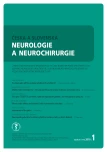A neurological view on spondylodiscitis
Authors:
T. Andrašinová 1; B. Adamová 1; R. Chaloupka 2; T. Andrašina 3
Authors‘ workplace:
Neurologická klinika LF MU a FN Brno
1; Ortopedická klinika LF MU a FN Brno
2; Klinika radiologie a nukleární medicíny LF MU a FN Brno
3
Published in:
Cesk Slov Neurol N 2018; 81(1): 86-92
Category:
Short Communication
doi:
https://doi.org/10.14735/amcsnn201786
Overview
Spondylodiscitis is a term used to indicate infection of the intervertebral disc and osteomyelitis of the adjacent vertebrae. It is a relatively rare disease in developed countries, representing 3– 5% of all skeletal infections. The inflammation is localized most often in the lumbar spine. Neurological deficits are present in 30– 50% of patients with spondylodiscitis. Frequent occurrence of chronic back pain in the general population as well as negative findings on plain radiography in the earlier stages of the disease oftentimes make the diagnosis difficult and delayed. A conservative therapeutic approach consists of antibiotic therapy which may be reduced to six weeks in uncomplicated cases according to new data. Compression of neural structures with neurological deficits, spinal instability, and failure of conservative treatment are all indications for surgical intervention. We are presenting a set of 11 patients with spondylodiscitis from which we selected 3 interesting case reports in order to demonstrate the various courses of the disease. Key words: spondylodiscitis – spine – inflammation – magnetic resonance imaging The authors declare they have no potential conflicts of interest concerning drugs, products, or services used in the study. The Editorial Board declares that the manuscript met the ICMJE “uniform requirements” for biomedical papers.
Sources
1. Rutges JP, Kempen DH, van Dijk M et al. Outcome of conservative and surgical treatment of pyogenic spondylodiscitis: a systematic literature review. Eur Spine J 2016; 25(4): 983– 999. doi: 10.1007/ s00586-015-4318-y.
2. Sur A, Tsang K, Brown M et al. Management of adult spontaneous spondylodiscitis and its rising incidence. Ann R Coll Surg Engl 2015; 97(6): 451– 455. doi: 10.1186/ s13256-016-1125-y.
3. Homagk L, Homagk N, Klauss JR et al. Spondylodiscitis severity code: scoring system for the classification and treatment of non-specific spondylodiscitis. Eur Spine J 2016; 25(4): 1012– 1020. doi: 10.1007/ s00586-015-3936-8.
4. Gouliouris T, Aliyu SH, Brown NM et al. Spondylodiscitis: update on diagnosis and management. J Antimicrob Chemother 2010; 65(3): 11– 24. doi: 10.1093/ jac/ dkq303.
5. Saez-Arenillas Martín A, Cerebrián Parra JL, Urda Martínez-Aedo AL et al. Management of infectious discitis. Outcome in one hundred and eight patients in a University Hospital. Int Orthop 2012; 36(2): 239– 244. doi: 10.1007/ s00264-011-1445-x.
6. Pola E, Autore G, Formica VM et al. New classification for the treatment of pyogenic spondylodiscitis: validation study on a population of 250 patients with a follow-up of 2 years. Eur Spine J 2017; 26 (Suppl 4): 479– 488. doi: 10.1007/ s00586-017-5043-5.
7. Trecarichi EM, Di Meco E, Mazzotta V et al. Tuberculous spondylodiscitis: epidemiology, clinical features, treatment, and outcome. Eur Rev Med Pharmacol Sci 2012; 16(2): 58– 72. doi: 10.1016/ j.spinee.2012.07.015.
8. Ramos A, Huddleston P, Patel R et al. Vertebral osteomyelitis due to candida species: a cohort study and review of the literature. Open J Orthop 2013; 3(2): 81– 89. doi: 10.4236/ ojo.2013.32016.
9. Ascione T, Balato G, Di Donato SL et al. Clinical and microbiological outcomes in haematogenous spondylodiscitis treated conservatively. Eur Spine J 2017; 26 (Suppl 4): 489– 495. doi: 10.1007/ s00586-017-5036-4.
10. Linhardt O, Matussek J, Refior HJ et al. Long-term results of ventro-dorsal versus ventral instrumentation fusion in the treatment of spondylitis. Int Orthop 2007; 31(1): 113– 119. doi: 10.1007/ s00264-006-0140-9.
11. Si M, Yang ZP, Li ZF et al. Anterior versus posterior fixation for the treatment of lumbar pyogenic vertebral osteomyelitis. Orthopedics 2013; 36(6): 831– 836. doi: 10.3928/ 01477447-20130523-33.
12. Berbari EF, Kanj SS, Kowalski TJ et al. Infectious Diseases Society of America. 2015 Infectious Diseases Society of America (IDSA) Clinical Practice Guidelines for the Diagnosis and Treatment of Native Vertebral Osteomyelitis in Adults. Clin Infect Dis 2015; 61(6): 26– 46. doi: 10.1093/ cid/ civ482.
13. Bernard L, Dinh A, Ghout I et al. Antibiotic treatment for 6 weeks versus 12 weeks in patients with pyogenic vertebral osteomyelitis: an open-label, non-inferiority, randomised, controlled trial. Lancet 2014; 385(9971): 875–882. doi: 10.1016/S0140-6736(14)61233-2.
Labels
Paediatric neurology Neurosurgery NeurologyArticle was published in
Czech and Slovak Neurology and Neurosurgery

2018 Issue 1
Most read in this issue
- A neurological view on spondylodiscitis
- Parosmia and phantosmia in patients with olfactory dysfunction
- Assessment of cognitive functions using short repeatable neuropsychological batteries
- Test of gestures (TEGEST) for a brief examination of episodic memory in mild cognitive impairment
